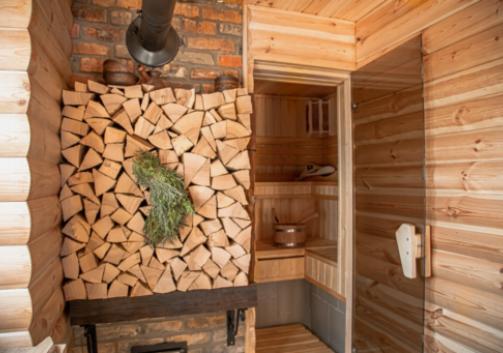Installing a Wood-Burning Stove: Safety and Best Practices
22 November 2025 by Jaya S.As a human writer specializing in saunas and DIY home and garden projects, I understand the importance of safety when it comes to installing a wood-burning stove. Proper installation and maintenance are crucial to ensure that your sauna remains a safe and enjoyable space for relaxation. In this article, we will explore fire safety regulations, best practices for insulating walls and ceilings, choosing the right location for your stove, and regular maintenance tips to keep your wood-burning stove operating safely. Let's dive in!

Understanding Fire Safety Regulations for Wood-Burning Stoves in Saunas
These regulations are put in place to ensure the safety of those using the sauna and to prevent the risk of fire hazards. One important regulation to be aware of is the clearance requirements for wood-burning stoves. It is essential to leave enough space between the stove and any combustible materials such as walls, ceilings, and flooring. This helps to prevent the risk of overheating and potential fire hazards. Additionally, it is important to ensure that the chimney and stovepipe are properly installed and maintained. This includes regular cleaning and inspections to prevent the buildup of creosote, which can lead to chimney fires. Another crucial aspect of fire safety regulations for wood-burning stoves in saunas is the proper ventilation of the space. It is important to have adequate ventilation to allow for the proper flow of air and to prevent the buildup of carbon monoxide. By understanding and following fire safety regulations for wood-burning stoves in saunas, you can ensure the safe and efficient operation of your stove while enjoying the warmth and comfort it provides.Best Practices for Insulating Walls and Ceilings Around a Wood-Burning Stove
When installing a wood-burning stove in a sauna, it is important to pay special attention to insulating the walls and ceilings surrounding the stove. Proper insulation not only helps to improve the efficiency of the stove, but also plays a crucial role in preventing potential fire hazards. Here are some best practices for insulating walls and ceilings around a wood-burning stove:Use fire-resistant materials: When insulating the walls and ceilings around a wood-burning stove, be sure to use fire-resistant materials that can withstand high temperatures. This will help to reduce the risk of the insulation catching on fire and spreading flames throughout the sauna.
Maintain proper clearance: It is important to maintain proper clearance between the wood-burning stove and the walls and ceilings. Check the manufacturer's guidelines for the recommended clearance distance, and be sure to follow these guidelines to prevent overheating and potential fire hazards.
Install a heat shield: Consider installing a heat shield behind the wood-burning stove to help protect the walls and ceilings from excessive heat. A heat shield can help to distribute heat more evenly and reduce the risk of the surrounding insulation becoming overheated.
Seal any gaps or cracks: Inspect the walls and ceilings for any gaps or cracks that could allow heat to escape or potentially ignite nearby materials. Seal any gaps or cracks with fire-resistant sealant to help prevent heat from reaching the surrounding insulation.
Ensure proper ventilation: Proper ventilation is essential when insulating walls and ceilings around a wood-burning stove. Good ventilation helps to prevent moisture buildup and allows for proper air circulation, which can help to reduce the risk of overheating and potential fire hazards. By following these best practices for insulating walls and ceilings around a wood-burning stove in a sauna, you can help to ensure the safety and efficiency of your heating system. Proper insulation not only improves the performance of the stove, but also helps to create a safe and comfortable environment for enjoying the sauna experience.
Choosing the Right Location for Installing a Wood-Burning Stove in a Sauna
Choosing the right location for installing a wood-burning stove in a sauna is crucial for ensuring both safety and efficiency. When determining the placement of the stove, it is important to consider factors such as ventilation, clearance requirements, and proximity to combustible materials. Additionally, the location of the stove should allow for easy access for maintenance and cleaning. By carefully selecting the location for the wood-burning stove, you can create a safe and comfortable sauna environment for years to come.Regular Maintenance Tips for Safe Operation of a Wood-Burning Stove
Regular maintenance is essential for ensuring the safe operation of a wood-burning stove in a sauna. Here are some tips to keep your stove in good working condition:Clean the stove regularly to remove ash, soot, and creosote buildup. This will help prevent chimney fires and improve the stove's efficiency.
Check the door gaskets for wear and tear, and replace them if necessary to ensure a tight seal.
Inspect the chimney for any blockages or damage, and clean it regularly to prevent buildup of creosote.
Check the stovepipe for any signs of rust or corrosion, and replace any damaged sections.
Test the stove's air controls to ensure proper ventilation and combustion.
Keep combustible materials at a safe distance from the stove to prevent accidental fires.
Have the stove and chimney inspected annually by a professional to ensure they are in good working condition. By following these maintenance tips, you can enjoy the warmth and comfort of your wood-burning stove in your sauna safely and efficiently.